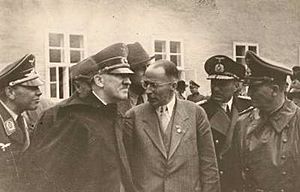Henrich Focke facts for kids
Henrich Focke (born October 8, 1890 – died February 25, 1979) was a German aviation expert from Bremen. He helped start the Focke-Wulf company. He is most famous for inventing the Focke-Wulf Fw 61, which was the first successful helicopter in Germany.
Contents
Biography
Early Life and Education
Henrich Focke was born in Bremen on October 8, 1890. He studied at Leibniz University Hannover. There, he became good friends with Georg Wulf in 1911.
In 1914, both Focke and Wulf joined the military. Focke was first put off due to heart problems. But he was later drafted into an infantry group. After serving on the Eastern front, he moved to the Imperial German Army Air Service.
Focke finished his studies in 1920. He earned a degree as a Dipl-Ing with high honors. His first job was designing water-gas systems for the Francke Company in Bremen.
Starting Focke-Wulf and Focke-Achgelis
In 1923, Focke, along with Wulf and Dr. Werner Naumann, co-founded a company called Focke-Wulf-Flugzeugbau GmbH. Sadly, in 1927, Wulf died while testing a plane called the Focke-Wulf F 19.
In 1930, Focke was offered a teaching position at the Danzig Institute of Technology, but he said no. The city of Bremen gave him the title of Professor in 1931. In the same year, Focke-Wulf joined with another company, Albatros Flugzeugwerke.
From 1933, Focke-Wulf built autogyros under a special agreement. These were based on designs by Juan de la Cierva. Focke was inspired by these machines. He then designed the world's first truly useful helicopter, the Focke-Wulf Fw 61. This helicopter first flew on June 26, 1936, with Hanna Reitsch as the pilot. In 1938, it also became the first practical helicopter to fly inside a building, at the Deutschlandhalle arena.
In 1936, Focke had to leave the Focke-Wulf company. This was due to pressure from shareholders. The main reason given was that the Nazi government considered him "politically unreliable." However, it is thought that the company wanted to use Focke-Wulf's factories to build Bf 109 aircraft instead. The company was taken over by AEG. But soon after, the Air Ministry, which was very impressed by the Fw 61 helicopter, suggested that Focke start a new company. This new company would focus only on developing helicopters. They asked him to design a better helicopter that could carry a 700 kg (1,500 lb) load.
So, Focke started the Focke-Achgelis company on April 27, 1937. He partnered with pilot Gerd Achgelis. They began working on new designs in Delmenhorst in 1938. This new company built an experimental helicopter called the Focke-Achgelis Fa 225. It used parts from a DFS 230 glider and a rotor from another helicopter.
Another interesting project was the Fa 330 kite. This kite had a rotor and could be quickly launched by a submarine. It was used as a towed spotter to look for things from above. It was kept in a waterproof container on the deck of the U-boat and used during the war. A powered version of this kite, the Fa 336, was being designed when the war ended. It was later built in France for testing after the war.
Focke later made the Fa 223, a large helicopter for carrying heavy loads. He also designed other helicopters like the Fa 224, Fa 266, Fa 269, Fa 283, Fa 284, and the Fa 336 during World War II. Only a few of the large Fa 223 Drache ("Dragon") helicopters were actually made. But even the first one, a prototype, set new helicopter records in 1940. It reached a speed of 182 km/h (113 mph) and could climb 8.8 meters per second (1,732 ft/min). These helicopters were mainly used to transport mountain troops, for rescue missions, and to recover crashed aircraft.
Postwar Contributions
On September 1, 1945, Focke signed a contract with the French company SNCASE. He helped them develop their SE-3000 passenger helicopter. This helicopter was based on his Focke-Achgelis Fa 223 "Drache" design and first flew in 1948.
In 1950, he worked as a designer for the North German Automobile Company in Wilhelmshaven.
In 1952, Focke and other members of his old design team went to work for Brazil's Centro Técnico Aeroespacial (CTA). This was the air force's technical center at the time. They worked on developing a "Convertiplano," which was a type of Convertiplane. This design used a lot of Focke's ideas from his wartime work on the Fa 269.
While working at the CTA, Focke also developed the BF-1 Beija-Flor (meaning "hummingbird"). This was a two-seater light helicopter. It first flew at Sao Jose dos Campos on January 22, 1959. The BF-1 was similar to the Cessna CH-1 in design. It had a 225 hp engine in the front. The BF-2 was developed from this and first flew on January 1, 1959. It flew many test flights until it was damaged in an accident.
Focke returned to Germany for good in 1956. He started developing a three-seater helicopter called the "Kolibri" ("hummingbird") at the Borgward company in Bremen. Its first flight was in 1958. While at Borgward, Focke set up a special wind tunnel in an old hangar. This wind tunnel was found again in 1997 and is now the main part of a museum dedicated to him.
After Borgward closed down in 1961, Focke became a consulting engineer. He worked with Vereinigte Flugtechnische Werke of Bremen and Deutsche Forschungsanstalt für Luft-und Raumfahrt. In 1961, Focke received the Ludwig-Prandtl-Ring award. This award is given by the German Society for Aeronautics and Astronautics for "outstanding contribution in the field of aerospace engineering." Focke passed away in Bremen on February 25, 1979.
In 1993, Focke was honored and added to the International Air & Space Hall of Fame at the San Diego Air & Space Museum.
See also
 In Spanish: Henrich Focke para niños
In Spanish: Henrich Focke para niños



